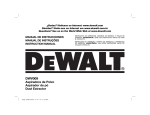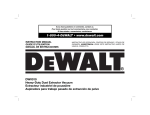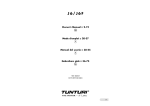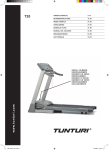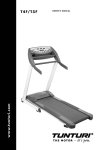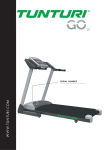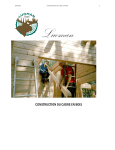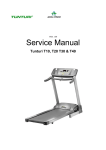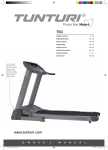Download Tunturi J9F Treadmill User Manual
Transcript
J9 • J9F OWNER'S MANUAL BETRIEBSANLEITUNG MODE D'EMPLOI MANUALE D'USO MANUAL DEL USUARIO HANDLEIDING BRUKSANVISNING w ww. tu nt ur i. co m KÄYTTÖOHJE • SERIAL NUMBER • SERIENNUMMER • NUMERO DE SERIE • NÚMERO DE SERIE • NUMERO DI SERIE • SERIENUMMER • SERIENNUMMER • SARJANUMERO 1 5 J 9/J 9 F J9 6 2 J 9/J 9 F J9 7 3 J 9/J 9 F J9F 4 J9F 2 OWNER'S MANUAL • J9 • J9F OWNER'S MANUAL J9•J9F I M P O R TA N T S A F E T Y INSTRUCTIONS This Owner’s Manual is an essential part of your training equipment: reading all instructions in this manual before you start using this appliance. The following precautions must always be followed: WA R N I N G : • Never use extension cords between the treadmill and your wall outlet. The device’s maximum power consumption is 10 A (EU) / 20 A (US). Outlets with fluctuating voltage of more than 5 %, may result in erratic performance or cause damage to treadmill electronics. Using electrical power other than that which has been specified in this manual, will ultimately void any warranty, implied or otherwise. to reduce any risk to persons: Keep hands clear of any moving parts. Never • place hands, feet or any other objects into any opening or under the treadmill. • Never leave the treadmill unattended when plugged in. Unplug from outlet when not in use, before putting on or taking off parts. To disconnect, turn all controls to the off position, then remove plug from outlet. • Close supervision is necessary when the treadmill used by, on, or near children, invalids, or disabled persons. • Use the treadmill only for its intended use as described in this manual. Do not use attachments not recommended by Tunturi. • Before you start using the treadmill, make sure that it functions correctly in every way. Do not use a faulty device. • Keep the cord away from heated surfaces. • J9 / J9F must not be used outdoors. J9 / J9F tolerates an environment measuring +10°C to +35°C. Air humidity must never exceed 90 %. • Do not attempt any servicing or adjustment other than those described in this manual. The given instructions must be followed carefully. • Never operate this treadmill if it has a damaged cord or plug, if it has been dropped or damaged, or dropped into water. Return the treadmill to a service center for repair. • Never operate the appliance with the air opening blocked. Keep the air openings free of lint, hair, and the like. • Do not operate where aerosol (spray) WA R N I N G : GB products are being used or where oxygen is being administered. • Strong electromagnetic fields may cause disturbances in the heart rate measurement. • The device must not be used by persons weighing over 135 kg (300 lbs). S AV E T H E S E I N S T R U C T I O N S ! WELCOME TO THE WORLD OF TUNTURI EXERCISING! Your choice shows that you really want to invest in your well-being and condition; it also shows you really value high quality and style. With Tunturi Fitness Equipment, you’ve chosen a high-quality, safe and motivating product as your training partner. Whatever your goal in training, we are certain this is the training equipment to get you there. A S S E M B LY Before assembling the device, insure all parts are present: Frame Power cord Assembly kit (contents are marked with an * in the spare part list) 1. 2. 3. In case of problems contact your Tunturi dealer. The packaging includes a disposable silicate bag for absorbing moisture during storage and transportation. The directions left, right, front and back are defined as seen from the exercising position. J9: HAND RAIL AND INTERFACE FIGUR ES 1, 2, 5 AND 6 Turn the user interface until the holes for the locking screws are in position and then attach by tightening the 4 screws on the rear side. Cut (M6x12) the green ribbon and attach the corner pieces with the transportation wheels to the lower ends of the hand rail with 3 Allen screws (M6x16) on both sides. Lift the handrail to the upright position, place the cover tubes between corner pieces and the frame and thread the attachment bolts through the tubes. Tighten the bolts with nuts. Place the multi-purpose rack with the plastic end pieces on the top of the hand rail, pull the lower edge of the rack over the support bolts on the hand rail sides and attach the plastic end pieces with screws to the top of the hand rail. Attach the 2 (M6x12) screws on the front side of the interface and remove the protective film from the display. 3 J 9 F : H A N D R A I L A N D I N T E R FA C E (FIGUR ES 3, 4, 5 AND 6) Turn the user interface until the holes for the locking screws are in position and then attach by tightening the 4 screws (M6x12) on the rear side. Cut the hand rail ribbon and place 2 pieces of styrox foam under the front end of the treadmill. Attach the folding frame to the treadmill with 3 Allen screws (M6x16) on both sides. Remove the styrox foam pieces. The running base must be held up during the gas spring installation, so you will need another person to support the running base. Thread the upper end of the gas spring (M8 thread) completely into the hexagonal bushing. NOTE! Attach the gas spring below the locking fork. Thread the gas spring by hand; do not use tools as these may damage the piston rod. Attach the lower end of the gas spring to the folding frame with an M8 screw and a nut. Lower the running base carefully and place the multi-purpose rack with the plastic end pieces on the top of the hand rail, pull the lower edge of the rack over the support bolts on the hand rail sides and attach the plastic end pieces with screws to the top of the hand rail. Attach the 2 screws (M6x12) on the front side of the interface and remove the protective film from the display. POWER CORD AND OWNER'S MANUAL • J9 • J9F GROUNDING INSTRUCTIONS 4 Plug the socket end of the power cord into the treadmill at the lower right front corner. Before connecting the device to a power source, make sure that local voltage matches that indicated on the type plate. The treadmill operates at either 230 V or 120 V (US-version). Turn on the power using the switch next to the socket on the treadmill. This treadmill must be grounded. If it should malfunction or breakdown, grounding provides a path of least resistance for electrical current to reduce the risk of electrical shock. This product is equipped with a cord having an equipmentgrounded conductor and a grounding plug. The plug must be plugged into an appropriate outlet that is properly installed and grounded in accordance with all local codes and ordinances. Do not use extension cables when connecting the equipment to the power source. DA N G E R ! Improper connection of the equipment-grounding conductor can result in a risk of electric shock. Check with a qualified electrician or serviceman if you are in doubt as to whether the product is properly grounded. Do not modify the plug provided with the product - if it will not fit the outlet, have a proper outlet installed by a qualified electrician. N O T E ! The version for use on a nominal 120-volt circuit has a grounding plug that looks like the plug illustrated. Make sure that the product is connected to an outlet having the same configuration as the plug. No adapter should be used with this product. SAFETY TETHER KEY The treadmill cannot be used if the tether key is not properly installed in the meter base; if the key is removed from its place near the electronic display, the treadmill will immediately stop. Insert the safety tether key into the meter base. Ensure that the clip of the safety tether key is properly attached to your clothing; as the cord tightens, make sure the clip does not detach itself from your clothing before the safety tether key disconnects from the user interface. EXERCISING No matter what your goal, you’ll get the best results by training at the right level of effort, and the best measure is your own heart-rate. First find your maximum heart-rate i.e. where the rate doesn’t increase with added effort. If you don’t know your maximum heart-rate, please use the following formula as a guide: Women: 226 - age Men: 220 - age These are average values and the maximum varies from person to person. The maximum heart-rate diminishes on average by one point per year. If you belong to one of the risk groups mentioned earlier, ask a doctor to measure your maximum heart-rate for you. We have defined three different heart-rate zones to help you with targeted training. Beginner: 50-60 % of maximum heart-rate Also suitable for weight-watchers, convalescents and those who haven’t exercised for a long time. Three sessions a week of at least a half-hour each is recommended. Regular exercise considerably improves beginners’ respiratory and circulatory performance and you will quickly feel your improvement. Trainer: 60-70 % of maximum heart-rate Perfect for improving and maintaining fitness. Even reasonable effort develops the heart and lungs effectively, training for a minimum of 30 minutes at least three times a week. To improve your condition still further, increase either frequency or effort, but not both at the same time! Active trainer: 70-80 % of maximum heart-rate Exercise at this level suits only the fittest and presupposes long-endurance workouts. OWNER'S MANUAL • J9 • J9F BE G I N N I N G A N E X E R C I S E S E S S I O N • To avoid muscular pain and strain, begin and end each workout by stretching. • Stand on the landing rails to the left and right of the running belt. Do not stand on the running belt. • Always hold the handrail for support when getting on or off the treadmill and when changing the speed during exercise. Do not jump off the running belt while it is moving! • If you experience nausea, dizziness or other abnormal symptoms while exercising, stop your workout at once and consult a physician. Set helps you define user weight, heart-rate alarm limits, audio signal use and units of measurement. Reset is the key to reset time, distance and energy consumption displays for all exercises. CUSTOM START FI N I S H I N G A N E X E R C I S E S E S S I O N In Manual mode, use Custom Start to begin an exercise where speed and elevation are preset by the user. You can save the Custom Start values by setting the desired speed and elevation, and then pressing the Custom Start key for 2 seconds: an audio signal indicates that the setting is saved. For user safety, the speed range on the key is 0,5-10 km/h (0,3-6,2 mph). • SETTING KEYS, OK AND SCAN Never leave the safety tether key in the treadmill. • Use the main power switch to turn the unit off. • Unplug the electrical cord from the wall outlet and from the treadmill. • If necessary clean the treadmill from sweat with a damp cloth. Do not use solvents. • Store the electrical cord where it is clear from all pathways and out of children’s reach. H O W T O M O T I VAT E Y O U R S E L F TO C O N T I N U E In order to reach the goals you have set, you’ll need to keep finding the motivation to continue so you achieve your ultimate goal: life-long health and a new quality of living. • Set yourself realistic targets. • Progress step-by-step according to your schedule. • Keep a fitness diary and write down your progress. • Change your way of exercising from time to time. • Use your imagination. • Learn self-discipline. One important aspect of your training is versatility. Varying your training exercises different muscle groups and helps maintain motivation. I N T E R FA C E GB Setting keys are used to set the values on-screen. The right arrow key is used for navigation, while the up/down keys are used to set values. The OK key in the middle of the setting keys is used to confirm your selections. Pressing SCAN key changes the profile display. SPEED CONTROL KEYS Speed control keys (Tortoise/Hare) are located below the display. Hare key increases the belt speed in 0,1 km/h (or 0,1 mph) increments, the tortoise key decreases it in 0,1 km/h (or 0,1 mph) increments. Pressing these keys longer makes the speed change faster. Track speed ranges from 0,5-18 km/h (0,3-11,2 mph). In some profiles you can replace these keys with the PSC feature. ELEVATION CONTROL KEYS Click the elevation up key to increase elevation in 1% increments, and the elevation down key to decrease it in 1% increments. Track elevation ranges from -2 % to 10 %. STOP Press STOP to end your exercise. Press STOP once in exercise profile training and the treadmill stops and moves into its waiting state for 5 minutes. You can restart the interrupted exercise by pressing the Hare key within 5 minutes. Press STOP twice to end your exercise. FU N C T I O N K E Y S SET AND RESET Manual is the default basic exercise mode when the device is switched on. In Manual mode you control the treadmill yourself. Control offers three different standard heartrate exercises. Prog provides 2 fitness tests and 7 preprogrammed exercise profiles. You can also create and save 5 profiles of your own. PSC allows you to adjust treadmill speed by changing your position on the track. With the Set key you can define the user weight (Weight), heart-rate alarm limits (Beat LO / HI ), audio signal use (Audio on / off ) and units of measurement (Units EU / USA ). 1. Press the Set key and a text indicating the value to be set will be displayed on the text line; the value will blink on and off. • Use the up/down setting keys to set the value and press OK ; this will also move you forward to setting the next value. 5 • Press any function key to exit the Set mode. N O T E ! Pressing the Set key during an exercise will stop the belt and finish the exercise. The Reset key resets energy consumption, time and distance displays for all exercises. D I S P L AY S E PA R AT E D I S P L AY S 1. SPEED Running deck speed measured in kilometres or miles per hour (0,5-18,0 km/h / 0,3-11,2 mph). 2 . TIME Elapsed time at 1 second intervals 00:00-59:59 up to 1 hour, and at 1 minute intervals thereafter 1:00-99:59. 3 . DISTANCE Accumulated distance in kilometers or miles (0.0-999.9). M A I N D I S P L AY Profile display: the letters beside the display indicate which profile is being displayed (mph, km/h = speed; kcal/min = energy consumption measurement during workout; heart = heart-rate level; up/down arrow = elevation angle) 2 . Letters indicating a selected function: Manual Control = user-controlled exercise; Pulse Control = standard heart-rate exercise (treadmill icon indicates the selected form of heart-rate exercise); Profiles = pre-programed exercise profiles, Own Profiles = user-designed exercise profiles; Test = walking test, Recovery = measurement of recovery pulse. 3 . Number line: kcal = energy consumption; arrow up/down = running deck elevation; heart = heartrate level. If heart-rate measurement is not used, the user interface displays --. A square blinks on the display at the pace of the measured heart rate to indicate that measurement is in operation. 1. OWNER'S MANUAL • J9 • J9F ERROR CODES 6 The user interface will display information about any operational faults. An error code begins with the abbreviation Err. 11 Motor heat protection off: Please check running deck lubrication. 13 Running deck speed exceeds set value: Please follow this manual’s instructions on using the device. 15 Running deck does not respond to controls: Please check running deck lubrication and follow this manual’s instructions on using the device. 71 Lift motor fault or lifting motor overload protection off: Please switch the device off for 5 minutes and then restart. If the error message does not disappear, please contact your local Tunturi distributor. Remove the error code by pressing the R ESET key. If any of these error codes appears repeatedly despite servicing, or if a code other than the above is displayed constantly, please contact your Tunturi dealer. POSITION SPEED CONTROL (PSC) Position Speed Control (PSC ) allows you to adjust running track speed by changing your position on the track. Move to the front of the track and it accelerates, and as you move back the track itself slows down. When you are walking or running in the middle section of the track the speed stays steady. N O T E ! You must wear a Polar heart rate belt when you use PSC ! A blinking square in the Heart Rate display indicates that heart rate measurement is in operation. N O T E ! Attach the holder of the safety tether key carefully to your shirt whenever you are using PSC. Adjust the length of the safety tether key wire so that it will be detached from the meter, if you move too far back. N O T E ! If you are exercising with PSC , there must not be another heart rate transmitter near the treadmill (minimum distance 2 m); the simultaneous signals of two transmitters endanger user safety by interfering with the PSC . Start the use of PSC by setting the speed zone limits. Press the PSC key. • PSC ON is displayed. Press OK . • SET UP Y ES is displayed. Press OK. • POSITION 1 Y ES is displayed. Step on the track as shown in figure Pos 1, the tips of your shoes level with the front edge of the roughened side panels. Press OK , and the meter will measure your distance on the basis of the heart rate signal. Measurement takes 6 seconds, and after that POSITION 2 Y ES is displayed. Position yourself as shown in figure Pos 2, the heels of your shoes level with the rear edge of the roughened side panels. Press OK , and the meter will measure your distance on the basis of the heart rate signal. Measurement takes 6 seconds, and after that SET UP R E ADY is displayed. 1. Pos 1 • Pos 2 If the meter cannot receive the heart rate signal or there are problems in measuring the distance, the meter will return to the SET UP display. In case of such an error, the text Hr Err is displayed for 5 seconds. OWNER'S MANUAL • J9 • J9F Select Manual exercise or standard heart rate exercise with automatic elevation adjustment. In these exercises you can adjust the track speed with PSC . The PSC signal light indicates that the feature is in operation. The operation of the PSC feature is indicated by the bars on the right edge of the display. They show in which speed zone you are currently running. 3 . Start the selected exercise by pressing the START (Hare) key, and adjust track speed by moving forward or back on the track. Please note that the speed adjustment keys (Tortoise/Hare) are also in operation during a PSC exercise. N O T E ! If you have not tried the PSC feature before, we recommend you start at slow speed. 4 . Stop the use of the PSC feature by pressing the STOP key twice at the end of the exercise. 5. If the speed zone limits are suitable for you, the next time you start exercising you can start PSC just by pressing the PSC key, and then select the desired training mode. If you want to adjust the speed zone limits, repeat phase 1. Please note that you can also select NO when setting the limits with the up/down arrow keys; selecting NO and then pressing OK will not change the limit in question, but you will move forward to the next adjustment step. 2. MANUAL Manual is the default user-controlled basic exercise mode when the device is switched on. In contrast to profile exercises, Manual means you can adjust running deck speed and elevation yourself during an exercise, if necessary. 1. Start the treadmill or press the Manual key. 2 . Start the training by pressing the Hare key. The belt will start moving at 0,5 km/h (or 0,3 mph). By pressing the Custom Start key, the belt accelerates to the preset speed and elevation values. • You can save the Custom Start values by setting the desired speed and elevation, and then pressing the Custom Start key for 2 seconds: an audio signal indicates that the setting is saved. For user safety, the speed range on the key is 0,5-10 km/h (0,3-6,2 mph). 3 . Steady yourself by holding onto the handlebars and carefully stepping onto the moving belt. Increase speed by pressing the Hare key until the desired speed is reached. To slow down, press the Tortoise key. You can also control your speed with PSC in Manual mode. 4 . Adjust the elevation during the training by using the elevation arrow keys. Press the elevation up key, and the back of the treadmill goes down, increasing the elevation in 1% increments. Press the elevation down key, and the back of the treadmill will rise, decreasing elevation in 1% increments. GB CONTROL Standard heart-rate exercises enable training within a selected heart rate level. Constant heart rate exercise requires your using the heart rate measurement system. 1. Select the desired heart-rate mode by pressing the Control key (indication light shows the selected mode): • Speed (indication light <<<) = pulse control is based on changing belt speed. If you wish, you can change the inclination angle of the belt during training. • Elevation (indication light up/down) = pulse control is based on changing treadmill inclination. In this mode you have to adjust the speed by yourself using either PSC or the Tortoise and Hare keys. • Combination (both indication lights)= automatic equal adjustment of both the inclination angle and the speed of the belt. 2 . Set the desired heart-rate with the up/down setting keys. • Press OK to confirm. 3 . Press the Hare key to start constant heart-rate exercise. • You can adjust the heart-rate level with the up/down setting keys during the exercise. • In the Speed and Combination exercises, you can set the upper limit to belt speed (default: 12 km/h / 7,4 mph) by pressing the Tortoise key during the exercise. You can adjust the belt speed limit with the Hare and Tortoise keys during the exercise; you can also control your speed with PSC. • You can change the heart-rate mode during the exercise. PROG Fitness Tests and heart-rate profiles require your using the heart-rate measurement system. FITNESS TEST Doing the Fitness Test will help you to discover your Fitness Index value. J9 / J9F uses the 2 km Walking Test. This is a so-called indirect test that measures your fitness level based on your heart-rate. The 2 km Test is preceded by a 3 minute warm-up period. We also recommend you continue walking slowly after the test, so that your heart-rate returns smoothly to normal. J9 uses the results to calculate your aerobic fitness index. The result is shown in ml/kg/min; e.g. an index value of 40 means that in a maximal performance the exerciser consumes 40 millilitres of oxygen per minute per each kilo of body weight. Press Prog key 3 until the display moves to the test mode (2 K M WALK TEST). • Confirm with the OK key. 1. 7 The user interface requests the following information to form the basis of the test: weight, height, sex and age. Please enter the information using the up/down setting keys and confirm with the OK key; that also moves you forward to setting the next value. 3 . You move automatically to the Test Warm-up for the test after entering your age. Running deck elevation is set at 1 % for the three-minute warm-up and in the walking test itself. Adjust speed with the Hare and Tortoise keys. Once the warm-up time display reaches zero, the walking test starts automatically. Walk as fast as you can, but don’t run! 4 . Your fitness index value will be displayed at the end of the test in the central display window. Press any function key to exit the walking test. 2. EXERCISE PROFILES T R A I N I N G W I T H P R E - P R O G R A M MED E X E R C I SE P R O F I L E S Press the Prog key until the desired exercise profile is displayed, e.g. PROFILE 3 (see the end of the manual for a detailed description of exercise profiles). The treadmill has 7 ready-to-use exercise profiles. • PRO 1, 2 AND 3 are speed/elevation profiles in which running deck speed and elevation change in a preset way; those values can also be user-adjusted if required. • PRO 4 AND 5 are heart-rate profiles in which running deck speed and elevation are adjusted according to how the exerciser’s heart-rate reacts to preset heart-rate changes. • PRO 6 is a speed profile in which running deck speed changes in a preset way; you can adjust elevation yourself, if you wish. • PRO 7 is an elevation profile in which running deck elevation changes in a preset way; you can adjust speed yourself. • Press OK to confirm. 2 . The text SET TIME and time are displayed. Set the duration of the exercise with the up/down keys. • Press OK to confirm. 3 .You can scale the speed of the exercise profile in 5% increments with the up/down arrow keys. 4 . Start the exercise profile selected by pressing the Hare key. You can also scale the profiles with the arrow keys during training, if the speed you chose is too easy or demanding. 5. Press STOP once and the treadmill stops and moves into its waiting state (hold) for 5 minutes. You can restart the interrupted exercise during the waiting state by pressing the Hare key. Once the 5 minute waiting period is over, the exercise has ended and the device returns to profile selection state. You can also end your exercise by pressing the STOP key twice. OWNER'S MANUAL • J9 • J9F 1. 8 If you complete the exercise profile, the track speed will decrease to 3.2 km/hr at the end of the profile, or if the profile ends at a lower speed, the track will continue at that speed, and the treadmill switches to Manual mode. 6. CREATING AND SAVING YOUR OWN TRAINING PROFILES Press the Prog key until the display goes to its Own Profiles state. Press OK to confirm your selections. 2 . The treadmill has 5 memory slots (OW N ) for your own exercise profiles. • Profiles 1-3 are for speed/elevation, in which you can set both running deck speed and elevation. • Profiles 4 and 5 are heart-rate profiles where you can set your heart-rate during the exercise. • The number line in the main window shows the memory position number (e.g. OW N 1 ). Please select the desired profile with the up/down arrow keys and press OK to confirm your choices. 3 . The text SET TIME and time are displayed. Set the duration of the exercise with the up/down keys. Press OK to confirm. 4 . Use the left/right setting keys to move in the profile to the position that you want to modify. Edit the profile with the up/down setting keys. • In the speed/elevation exercise, the upper profile displayed shows speed and the lower the changes in elevation angle. The display shows the whole profile. Once you’ve run through the speed profile, you will automatically move to the elevation profile; and once you’ve finished that, you return to the beginning of the speed profile again. • In the heart-rate exercise, you create only one profile that indicates changes in your heart-rate level. • Press OK to save your profiles. 5. Start a profile exercise by pressing the Hare key. 6 . If you want to edit a profile you’ve already created, select that profile and edit it in just the same way you created it. 7. To remove a profile you created earlier, select the relevant profile and press the Reset key. 1. MEASUREMENT OF RECOVERY PULSE Press PROG key twice. The text R ECOV ERY TEST appears on display. • Press OK to confirm. In order to improve the reliability of recovery pulse measurement, always try to standardize the measurement situation as accurately as possible; start measuring at the same heart rate level as precisely as possible. The measurement takes two minutes, during which the text R ECOV ERY TEST and the heart rate are displayed. Try not to move during the measurement. At the end of the period the recovery ratio percentage are displayed. The smaller the reading the fitter you are. Note that 1. OWNER'S MANUAL • J9 • J9F results are dependent on the starting pulse level, they are individual and not directly comparable with those of others. MAINTENANCE Do not attempt any servicing or adjustment other than those described in this manual. Any other servicing must be performed by an authorized service representative. Check the tightness of all fixing screws once a year. Do not overtighten. C AU T I O N ! LU B R I C AT I N G T H E R U N N I N G D E C K Lubrication is the most important service activity for the treadmill. This is absolutely essential, if the friction of the running deck increases noticeably or the motor begins to heat up; increased friction is indicated by jerky movement of the belt or by error code 15 appearing on the display. Insufficient lubrication will cause the belt, running deck and motor to wear out and break. The need for re-lubrication depends to a great extent on the running styles and weight of the user: heavy user weight and slow speed put particular strain on the device and therefore demand greater lubrication. We recommend you check the lubrication after every 100 hours of use. If the inside of the belt is not moist with T-Lube, lubricate the belt with T-Lube immediately. Use only T-Lube lubricant to lubricate the treadmill. Contact your local Tunturi distributor for further supplies of T-Lube. GB CLEANING THE TREADMILL Wipe the treadmill surfaces, especially the handlebars and meter from dust with a damp cloth or towel. Do not use solvents. Use a small vacuum nozzle to carefully vacuum around all visible components (belt, running deck, side rails etc.). To clean the underside of the treadmill, carefully turn the treadmill on its side, or if your treadmill is J9F, lift the running deck to the storage position. ALIGNING THE RUNNING BELT Monitor belt tracking during exercise and make adjustments as needed. The belt should run in the centre of the treadmill. Alignment is not usually needed, provided • the treadmill is placed on an even, solid and horizontal surface and the belt is correctly tensioned • the alignment of the belt is correct It is, however, possible for the belt to be pushed to one side due to the user’s running style (e.g. more weight on one foot). The alignment of the belt is adjusted by turning the two bolts at the back of the treadmill. Align the belt according to the following instructions: Turn the power switch on and increase the treadmill’s speed to 5 km/h (3 mph). 2 . If the belt drifts to the left, turn the left adjustment bolt 1/8 turn clockwise and the right adjustment bolt 1/8 turn anticlockwise. Do not turn more than 1/8 at the time as already very small adjustments effect the alignment. • If the belt drifts to the right, turn the right adjustment bolt 1/8 turn clockwise and the left adjustment bolt 1/8 turn anticlockwise. 3 . If the belt remains centered the adjustment is correct. If not, continue to make small adjustments as above until the belt is correctly aligned. If the belt is allowed run across to one side for long periods of time the edges of the belt may be damaged and the treadmill may not continue to operate correctly. Any damage to the belt caused by the lack of necessary adjustment will not be covered by the warranty. 1. Attach the nozzle to the T-Lube container. Let the treadmill run at 1,5 km/h. Push the nozzle completely into either lubrication pipe. Spray T-Lube into the pipe until the belt has rotated once (see the seam of the belt), stop spraying and pull the nozzle out. The treadmill is instantly ready for use. 9 A D J U S T I N G T H E B E LT T E N S I O N The belt must be tensioned if it begins to slip on the rollers. In normal use, however, keep the belt as loose as possible! The belt tension is adjusted by turning the same screws as used for aligning the running belt. If turning the screws will not effect the belt tension, please contact your Tunturi dealer. 1. Increase the treadmill’s speed to 5 km/h (3 mph). 2 . Turn both adjustment screws an equal amount, 1/8 turn clockwise. 3 . Try to slow the belt down by holding onto the handrails and braking as you walk (as if you were walking downhill). If the belt slips, turn another 1/8 turn and repeat the test. When braking heavily the belt may slip. MALFUNCTIONS Despite continuous quality control, defects and malfunctions caused by individual components may occur in the equipment. In most cases it’s unnecessary to take the whole device in for repair, as it’s usually sufficient to replace the defective part. If you require spare parts or the equipment does not function properly during use, contact your Tunturi dealer. Always give the model, serial number of your equipment and in case of malfunctions also conditions of use, nature of malfunction and any error code. Use only spare parts mentioned in the spare part list. If there is a fault in the user interface display, unscrew the 10 locking screws. Detach the cable connector by pressing the clip towards the cable and pulling it off. Be careful not to drop the cable inside the tube. Please contact your local Tunturi distributor for further information on repairing or replacing the meter. When reinstalling the user interface, please tug lightly at the cable to make sure that it’s properly locked. N O T E ! The text “Self cal” on display indicates automatic re-calibration of the lift motor. NOTE ! OWNER'S MANUAL • J9 • J9F MOVING AND STORAGE 10 Before moving J9, be sure the power cord is unplugged from the wall and the treadmill. Lift the treadmill from the rear to an angle of about 30 degrees and push it on the front wheels. Lower the treadmill carefully onto the floor. You can lift up the running deck of J9F to a space-saving storage position: Turn off the power switch. Take hold of the frame tube underneath the rear part of the running base and lift the running base up. The gas spring is designed to make lifting the running base easier. Always remember to ensure that the running base is locked in the storage position! Before moving J9F, be sure the power cord is unplugged from the wall and the treadmill; lift up the running base until it becomes locked. Stand behind the treadmill and support it with your foot on a transportation wheel, grip the hand rails and tilt the treadmill towards yourself so that it rests on the transportation wheels. Lower the treadmill carefully onto the floor, again supporting it with your foot. N O T E ! Transport the treadmill with extreme caution over uneven surfaces, for example over a step. The treadmill should never be transported upstairs using the wheels over the steps, instead it must be carried. N O T E ! The running belt needs to be realigned and centered after moving. To prevent malfunctioning of the treadmill, store it in a dry place with as little temperature variation as possible, protected against dust. Always unplug the treadmill from the electrical outlet when not in use. C AU T I O N ! T E C H N I C A L D ATA LENGTH ...........................................153 cm / 60” (storage position 70 cm / 28”) HEIGHT ...........................................142 cm / 56” (storage position 155 cm / 61”) W IDTH ..............................................82 cm / 32” W EIGHT ....................................... 80 kg / 177 lbs RUNNING SUR FACE .......... 46 x 135 cm / 18 x 53” SPEED ..................... 0,5 -18 km/h / 0,3-11,2 mph ELEVATION R ANGE ............................. -2 - +10 % MOTOR ........................ 2,5 HP (continuous duty) M A X. USER W EIGHT ..................135 kg (300 lbs). J9 / J9F treadmill meets the requirements of the EU’s EMC Directives on electromagnetic compatibility (89/336/EEC) and electrical equipment designed for use within certain voltage limits (73/23/EEC). This product therefore carries the CE label. J9 / J9F North American versions (120 V) comply with FCC requirements on electromagnetic compatibility and are accordingly marked with the FCC label. J9 / J9F treadmill meets EN precision and safety standards (Class A, EN-957, parts 1 and 6). P 1 : H I L L WA L K Speed km/h, Inclination % 7 6 5 4 3 2 1 0 1 2 3 4 5 6 7 8 9 10 11 12 13 14 15 16 17 18 7 8 9 10 11 12 13 14 15 16 17 18 P2: HILL JOG 8 Speed km/h, Inclination % 7 6 5 4 3 2 1 0 1 2 3 4 5 6 P3: HILL RUN Speed km/h, Inclination % 14 12 10 8 6 4 2 0 1 76 2 3 4 5 6 7 8 9 10 11 12 13 14 15 16 17 18 J9•J9F P 4 : FAT B U R N E R 140 120 Heart rate 100 80 60 40 20 0 1 2 3 4 5 6 7 8 9 10 11 12 13 14 15 16 17 18 8 9 10 11 12 13 14 15 16 17 18 8 9 10 11 12 13 14 15 16 17 18 12 13 14 15 16 17 18 P5: CARDIO 160 140 Heart rate 120 100 80 60 40 20 0 1 2 3 4 5 6 7 P 6 : I N T E R VA L 14 12 Speed km/h 10 8 6 4 2 0 1 2 3 4 5 6 7 P7: ROLLING HILLS 5 Inclination % 4 3 2 1 0 1 2 3 4 5 6 7 8 9 10 11 77 78 1 103 4034 Frame 1 - Screw 8 2 233 4024 User interface (incl. el., 4) 1 10 103 4036 M8x25 DIN 7991 Front support, J9F 1 *- M6x12 DIN 912 Screw 6 - M6x20 DIN 939 Screw, J9F, 6 3 173 4065 User interface lower cover 1 *- M6 DIN 125 Washer 6 - KB 40x12 WN-1441 Screw 6 *- M6 DIN 985 Nut nylon 6 4 233 4026 Membrane 1 11 643 4004 Spring, J9F (10 pcs/set) 2 8 543 4034 Hand rail bracket, pair, J9 1 - Screw 2 - M6x20 DIN 939 Screw, J9 6 13 533 1029 Wheel 4 *- M6 DIN 125 Washer 6 14 673 500 88 Snap locking 4 *- M6 DIN 985 Nut nylon 6 15 533 4006 Stand foot, pair 1 9 503 4038 Hand rail fulcrum 2 - M5 DIN 9021 Washer 2 - M8 DIN 934 Nut 8 - M5x14 DIN 7985 Screw 2 M6x12 DIN 912 J9•J9F 16 203 4027 Hand rail, R 1 51 533 251 87 Plug 2 17 203 4028 Hand rail, L 1 - M5 DIN 9021 Washer 2 18 213 4005 Handle grip 1 - M5x20 DIN 7500-C Screw 19 533 4050 Sleeve 2 52 403 4071 Mains cable, EUR 1 - M8 DIN 934 Nut 2 - Mains cable, USA 1 - M8x25 DIN 914 403 4070 2 Screw 2 56a 403 4084 Sensor 1 20 203 4029 Hand rail, pair (incl. 18) 1 - Screw 2 - M6x25 DIN 912 Screw 4 56b 403 4082 Cable 1 - M6 DIN 6798A Washer 4 56c 403 4083 Meter cable 1 21 433 4027 Safety guide 2 59 403 4108 Power board, EUR 1 22 173 4053 Rack 1 - 403 4109 Power board, USA 1 *25 523 4034 Sleeve, J9 2 - M5 DIN 6798 I Washer /1 pc grounding 5 *- M8x80 DIN 912 Screw, J9 2 - M5x14 DIN 7985 Screw /1 pc grounding 5 *- M8 DIN 985 M4x10 DIN 7985 Nut nylon, J9 2 - 403 4091 Transformer, EUR 1 26 173 4054 Side profile cover, pair 1 - 403 4093 Transformer, USA 1 - Washer 2 Screw 2 - M4 DIN 125 29 403 4054 M8x20 ISO 7380 Safety switch 1 - KB 35x6 WN-1442 Screw 2 *31 403 4055 Safety key 1 - 403 470 Mains switch, EUR 1 32 103 4033 Lift arm 1 - 403 471 Mains switch, USA 1 - M8x20 DIN 912 Screw 2 - 403 4090 Mains cable socket 1 - M8 DIN 125 Washer 2 60 813 4021 Motor 1 33 523 4033 Sleeve (10 pcs/set) 2 - 663 4004 Wedge 2 35 813 4020 Lift motor 1 - 263 4004 Belt wheel 1 36 523 4032 Roller, rear 1 - M6x8 DIN 916 Screw 2 - Screw 2 - 303 4007 Motor fan 1 37 523 4031 Roller, front 1 - 303 4008 Flywheel 1 - M8 DIN 125 Washer 2 - M6x8 DIN 916 Screw 2 - M8x30 DIN 933 M8x50 DIN 912 Screw 2 61 503 4031 Motor bracket 1 38 533 4010 Rubber sheet 2 - M8x12 DIN 933 Screw, upper bracket/motor 2 39 513 4002 Belt tightener frame 1 - M8 DIN 125 Washer, upper bracket/frame 2 - 8 DIN 471 Retaining 1 - M8x25 DIN 933 Screw, upper bracket/frame 2 - M8 DIN 936 Nut 1 62 503 4032 Motor bracket 1 - M8x40 ISO 7380 Screw 1 - M8x25 DIN 939 Screw 2 - M8 DIN 985 41 533 4040 Rubber bumper, Nut nylon 2 EUR (4 pcs/set) 6 64 443 4011 Drive belt 1 - M8x10 ISO 7380 Screw 10.9, side rail 4 69 173 4050 Dust cover 1 - M8x25 DIN 7991 Screw, deck 6 - M5 DIN 9021 Washer 2 41 533 4051 Rubber bumper, USA 2 - M5x20 DIN 7985 Screw 4 - Screw 10.9, side rail 2 73 343 4008 Axle 2 42 643 4005 Leaf spring, USA 4 - Retaining 4 - M8x10 ISO 7380 Screw 10.9, side rail 2 76 423 4059 Decal set 1 - M8x25 DIN 7991 Screw, deck 8 82 163 4005 Cas spring, J9F 1 43 433 4023 Deck 1 *- M8x35 ISO 7380 Screw, J9F 1 *- M8 DIN 985 Nut nylon, J9F 1 M8x10 ISO 7380 44 433 4026 Belt guide, pair 1 - Screw 10.9, side rail M8x14 ISO 7380 46 443 4010 Belt 1 47 173 4051 Cover, front roller - KB 40x12 WN-1441 Screw, frame 2 Locking lever, J9F(axle, screw) 1 - Screw M4x10 DIN 553 1 4 Cover, rear roller 1 - Screw 2 Landing, pair 1 M8x20 ISO 7380 84 513 4003 1 48 173 4052 49 433 4024 10 DIN 471 79 www.tunturi.co m TUNTURI OY LTD P.O.BOX 750, FIN-20361 Turku, Finland Tel. +358 (0)2 513 31 Fax +358 (0)2 513 3323 www.tunturi.com 5834027















